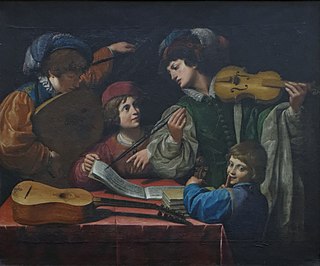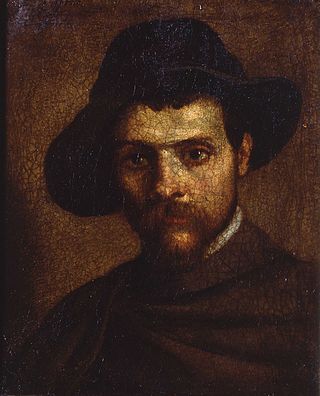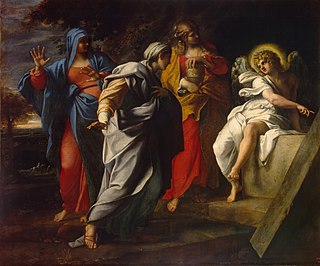
Agostino Carracci was an Italian painter, printmaker, tapestry designer, and art teacher. He was, together with his brother, Annibale Carracci, and cousin, Ludovico Carracci, one of the founders of the Accademia degli Incamminati in Bologna. Intended to devise alternatives to the Mannerist style favored in the preceding decades, this teaching academy helped propel painters of the School of Bologna to prominence.

Antonio Marziale Carracci was an Italian painter. He was the natural son of Agostino Carracci.

Elisabetta Sirani was an Italian Baroque painter and printmaker who died in unexplained circumstances at the age of 27. She was one of the first women artists in early modern Bologna, who established an academy for other women artists.

Leonello Spada was an Italian painter of the Baroque period, active in Rome and his native city of Bologna, where he became known as one of the followers of Caravaggio.

Bartolomeo Cesi was an Italian painter and draftsman of the Bolognese School. He made easel paintings as well as frescoes. He is known mainly for his religious paintings but he also painted portraits and mythological scenes.

Carlo Cesare Malvasia (1616–1693) was an Italian scholar and art historian from Bologna, best known for his biographies of Baroque artists titled Felsina pittrice, published in 1678. Together with his contemporary Giovanni Pietro Bellori, Malvasia is considered "among the best informed and most intelligent historians and critics of art who ever lived."
The Accademia degli Incamminati was one of the first art academies in Italy, founded in 1582 in Bologna.

Cesare Rinaldi an Italian early Baroque poet.

The Carracci were a Bolognese family of artists that played an instrumental role in bringing forth the Baroque style in painting. Brothers Annibale (1560–1609) and Agostino (1557–1602) along with their cousin Ludovico (1555–1619) worked collaboratively. The Carracci family left their legacy in art theory by starting a school for artists in 1582. The school was called the Accademia degli Incamminati, and its main focus was to oppose and challenge Mannerist artistic practices and principles in order to create a renewed art of naturalism and expressive persuasion.

Eleonora Monti was an 18th-century Italian artist best known as a portraitist. She spent much of her career in the city of Brescia, Italy, but is also affiliated with the city of Bologna. She was made an honorary member of the Accademia Clementina in Bologna in 1767, one of few women painters at the time to be recognized institutionally.
Marjorie Elizabeth Cropper is a British-born art historian with a special interest in Italian and French Renaissance and Baroque art and art literature. Dean of the National Gallery of Art’s Center for Advanced Study in the Visual Arts (CASVA) since December 2000, she previously held positions as Professor of Art History at Johns Hopkins University and director of the university’s Charles S. Singleton Center for Italian Studies at Villa Spelman in Florence.

Saint Sebastian Thrown into the Cloaca Maxima is a 1612 oil on canvas painting by Ludovico Carracci, now in the Getty Museum in Los Angeles, which acquired it in 1971. A preparatory drawing survives in the Louvre.

Self-Portrait is a 1593 oil on canvas painting by Annibale Carracci, now in the Galleria Nazionale di Parma. It is dated 17 April 1593 on the top left of the canvas.

Crucifixion with Saints or Crucifixion with Mourners and Saints Bernardino of Siena, Francis of Assisi and Petronius is a 1583 oil on canvas, now in the church of Santa Maria della Carità in Bologna. The work was originally sited in the Macchiavelli chapel in San Nicolò di San Felice, Bologna, next to Santa Maria della Carità, which was destroyed by bombing during the Second World War. It was then temporarily moved to the Soprintendenza di Bologna and finally to its current home.

The Three Marys at the Tomb, The Three Marys or The Pious Women at Christ's Tomb is a 1598 oil on canvas painting by Annibale Carracci, now in the Hermitage Museum in Saint Petersburg, which acquired it in 1836.

Pietà with Saints Clare, Francis and Mary Magdalene is a 1585 oil on canvas painting by Annibale Carracci, now in the Galleria nazionale di Parma.

Pietà with Saint Francis and Saint Mary Magdalene is a 1602-1607 oil on canvas painting by Annibale Carraci. Now in the Louvre, it was looted from the Mattei family chapel in San Francesco a Ripa in Rome by Napoleon's troops in 1797 and was not returned at the end of the Napoleonic Wars.

Portrait of Monsignor Giovanni Battista Agucchi is a 1604 oil-on-canvas painting now in York Art Gallery, to which it was presented via the National Art Collections Fund in 1955 by Francis Denis Lycett Green (1893–1959), a collector and younger brother of Sir Edward Arthur Lycett Green, 3rd Baronet. Long attributed to Domenichino, it is now usually attributed to Annibale Carracci, though some art historians still support the old attribution based on archival discoveries. The Gallery accepts the new attribution, though this is not yet reflected in its ArtUK entry.

The Last Communion of Saint Jerome or The Communion of Saint Jerome is an oil on canvas painting by Italian painter Agostino Carracci, created c. 1592-1597. It was produced for San Girolamo alla Certosa church in Bologna and it is now held in the Pinacoteca Nazionale di Bologna.

The Accademia dei Gelati was a learned society of intellectuals, mainly noblemen, that significantly influenced the cultural and political life of Baroque Bologna. It is considered one of the most important 17th-century Italian academies.



















